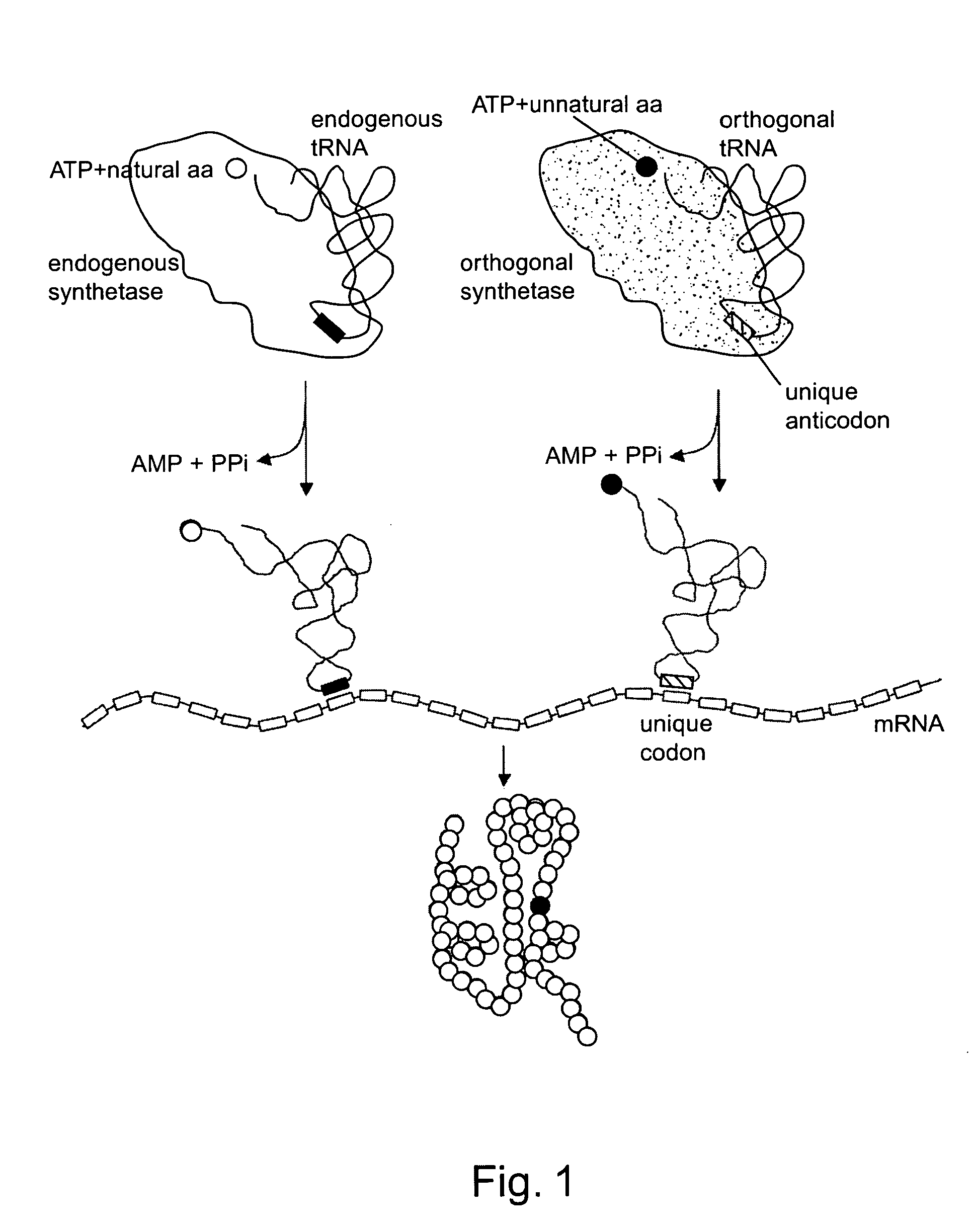Methods and composition for the production of orthogonal tRNA-aminoacyltRNA synthetase pairs
a technology of aminoacyltrna and synthetase, which is applied in the field of translation biochemistry, can solve the problems of limited synthesis of routine solid-phase peptides, limited protein changes, and difficult scaling of methods, and achieves the effect of improving or enhancing enzymatic properties
- Summary
- Abstract
- Description
- Claims
- Application Information
AI Technical Summary
Benefits of technology
Problems solved by technology
Method used
Image
Examples
example 1
Improvement of Orthogonality of a tRNA from Methanococcus jannaschii
[0224] Because of the complex nature of tRNA-synthetase interactions that are required to achieve a high degree of fidelity in protein translation, the rational design of orthogonal tRNA-synthetase pairs is difficult. This example describes methods that exploit the poor cross recognition of some interspecies tRNA-synthetase pairs, coupled with subsequent in vivo evolution of tRNAs with enhanced orthogonality. See, also, L. Wang and P. G. Schultz, Chem. Biol., 8:883 (2001). Specifically, a library of amber suppressor tRNAs derived from Methanococcus jannaschii tRNATyr was generated. tRNATyrCUAs that are substrates for endogenous Escherichia coli aminoacyl-tRNA synthetases were deleted from the pool by negative selection based on suppression of amber nonsense mutations in the barnase gene. The remaining tRNATyrCUAs were then selected for their ability to suppress amber nonsense codons in the β-lactamase gene in the p...
example 2
Mutating TyrRS so that it Charges the mutRNA Tyr / CUA with an Unnatural Amino Acid, O-methyl-L-tyrosine
[0245] A unique transfer RNA (tRNA)-aminoacyl tRNA synthetase pair has been generated that expands the number of genetically encoded amino acids in Escherichia coli. When introduced into Escherichia coli, this pair leads to the in vivo incorporation of the synthetic amino acid O-methyl-L-tyrosine, added exogenously to the growth medium, into protein in response to an amber nonsense codon. The fidelity of translation is greater than 99%, as determined by analysis of dihydrofolate reductase containing the unnatural amino acid. This approach provides a general method for increasing the genetic repertoire of living cells to include a variety of amino acids with novel structural, chemical and physical properties not found in the common twenty amino acids.
[0246] An orthogonal tRNA / synthetase pair in Escherichia coli can be generated by importing a pair from a different organism, if cros...
example 3
Mutating TyrRS so that it Charges the mutRNA Tyr / CUA with an Unnatural Amino Acid, L-3-(2-Napthyl)alanine
[0259] This example provides another orthogonal pair that can be used to incorporate a second unnatural amino acid, L-3-(2-Napthyl)alanine into proteins in an organism, e.g., Escherichia coli. An example of the methods used to generate the orthogonal pair that incorporates the unnatural amino acid into proteins is described below. More details describing the incorporation of the unnatural amino acid into a protein can be found in corresponding patent application “In vivo incorporation of unnatural amino acid” attorney docket number 54-000120PC / US incorporated herein by reference.
[0260] An amber stop codon and its corresponding orthogonal amber suppressor tRNA, mu tRNACUATyr, were selected to encode an unnatural amino acid. As described above, and see Wang & Schultz, Chem. Biol. 8:883-890 (2001). The Methanococcus jannaschii tyrosyl-tRNA synthetase (TyrRS) was used as the starti...
PUM
| Property | Measurement | Unit |
|---|---|---|
| Composition | aaaaa | aaaaa |
Abstract
Description
Claims
Application Information
 Login to View More
Login to View More - R&D
- Intellectual Property
- Life Sciences
- Materials
- Tech Scout
- Unparalleled Data Quality
- Higher Quality Content
- 60% Fewer Hallucinations
Browse by: Latest US Patents, China's latest patents, Technical Efficacy Thesaurus, Application Domain, Technology Topic, Popular Technical Reports.
© 2025 PatSnap. All rights reserved.Legal|Privacy policy|Modern Slavery Act Transparency Statement|Sitemap|About US| Contact US: help@patsnap.com



